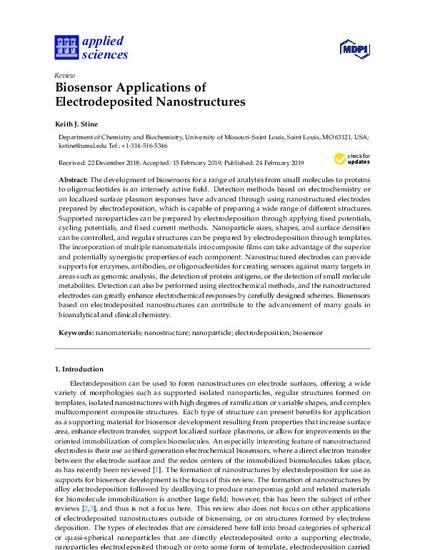
Article
Biosensor Applications of Electrodeposited Nanostructures
Applied Sciences (Switzerland)
(2019)
Abstract
The development of biosensors for a range of analytes from small molecules to proteins to oligonucleotides is an intensely active field. Detection methods based on electrochemistry or on localized surface plasmon responses have advanced through using nanostructured electrodes prepared by electrodeposition, which is capable of preparing a wide range of different structures. Supported nanoparticles can be prepared by electrodeposition through applying fixed potentials, cycling potentials, and fixed current methods. Nanoparticle sizes, shapes, and surface densities can be controlled, and regular structures can be prepared by electrodeposition through templates. The incorporation of multiple nanomaterials into composite films can take advantage of the superior and potentially synergistic properties of each component. Nanostructured electrodes can provide supports for enzymes, antibodies, or oligonucleotides for creating sensors against many targets in areas such as genomic analysis, the detection of protein antigens, or the detection of small molecule metabolites. Detection can also be performed using electrochemical methods, and the nanostructured electrodes can greatly enhance electrochemical responses by carefully designed schemes. Biosensors based on electrodeposited nanostructures can contribute to the advancement of many goals in bioanalytical and clinical chemistry.
Disciplines
Publication Date
February 24, 2019
DOI
10.3390/app9040797
Publisher Statement
doi: 10.3390/app9040797
Citation Information
Keith Stine. "Biosensor Applications of Electrodeposited Nanostructures" Applied Sciences (Switzerland) Vol. 9 Iss. 4 (2019) p. 1 - 40 Available at: http://works.bepress.com/keith-stine/86/
Creative Commons license

This work is licensed under a Creative Commons CC_BY International License.
